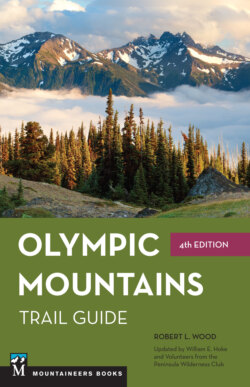Читать книгу Olympic Mountains Trail Guide - Robert Wood - Страница 26
На сайте Литреса книга снята с продажи.
HAZARDS
ОглавлениеOccasionally, one is amazed at the temerity exhibited by inexperienced hikers with regard to traveling in the Olympics. With little knowledge of what they face, they will start out—often alone and ill-equipped—to walk across the mountains or to seek solitude in remote, almost inaccessible areas. Often they do not understand that it is still winter in the high mountains although on the lowlands the warm sunshine may indicate that spring has arrived. Hardly a year goes by that we do not read or hear of someone getting lost in the mountains and either suffering death or severe injury. As a consequence, most hikers would be well-advised not to travel alone in the Olympics.
Nevertheless, in all honesty I cannot say that it is dangerous to do so—at least during the summer and early fall months when one is less likely to be caught by sudden, unexpected storms. I have done a great deal of hiking alone, and on such occasions I am doubly cautious. However, my personal experience should not be taken by readers as a recommendation that they go on solitary hikes. In this respect, it might be well to point out that during the summer months the main trails—and sometimes the secondary ones—are heavily traveled by lone individuals as well as by parties numbering up to the maximum allowed. At such a time the person who hikes without companions is not really alone.
Wilderness is deceptive, its dangers largely hidden so far as the uninitiated are concerned. Consequently, the hiker who exercises poor judgment—whether through inexperience or imprudence—may suffer serious injury or death due to a mishap. At times even the seasoned backpacker is the victim of carelessness, and lack of knowledge is often responsible for the neophyte wandering into terrain avoided by the sophisticated hiker.
The dangers in the Olympics are many. The rivers that flow swift and cold over boulder-strewn beds are often unsafe to cross. Caution should be exercised when wading or crossing on slippery logs. Other hazards include the tangled windfalls in the forests, impassable canyons, slippery heather, scree slopes, and of course glaciers. The latter are broken by deep crevasses, which are often hidden beneath snow. No one should venture upon them except mountaineers equipped with climbing paraphernalia. Many snowfields are dangerous because they are undermined by streams or lie in avalanche paths. However, the greatest hazard in the Olympics is uncertain weather. Fogs move in rapidly, confusing one’s sense of direction, and sudden storms may bring snow and freezing temperatures to the higher peaks, even in the middle of summer. On clear nights, fog often forms in the river bottoms, covering the lowlands under a dense blanket, but the sun usually breaks through during the morning; thus the afternoons are likely to be clear and warm. But sometimes the fog comes and goes all day, the peaks seldom revealing themselves.
One warning signal should always be heeded. When a well-developed storm moves in from the ocean and dark clouds begin to cascade like waterfalls through the gaps in the ridges, one can expect heavy rain within an hour or two, preceded by strong winds. On the glaciers, where no barriers exist to block the wind, the gusts may be so strong that climbers have to lean against the charge of rain or sleet. Quite often the passage of the front will be followed by several days of unsettled weather, with low clouds drifting about, patches of blue sky, and intermittent precipitation.
